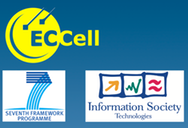The logical next step is the encapsulation of small molecules in scpDNA vesicles. Beside realization of entrapment of small molecules in the course of vesicle formation (passive loading) an enrichment of the payload can be achieved when a pH transmebrane gradient is employed between the vesicle interior and the surrounding medium (active loading). In this case the higher concentration of the entrapped molecules is due to different permeabilities of charged versus non charged small molecule species. Similar experiments have been carried out for loading of liposomes with anticancer drugs for therapeutic purposes.(Dos Santos N, Cox KA, McKenzie CA, van Baarda F, Gallagher RC, Karlsson G, Edwards K, Mayer LD, Allen C, Bally MB Biochimica et Biophysica Acta-Biomembranes 1661: 47-60 2004) Instead of employing a pharmaceutically active ingredient we will use an environmentally sensitive fluorescent dye that generates an output signal which is easily detectable upon release from the vesicles into a solution with different pH. Moreover, it will be possible to hybridize shorter DNA sequences than that of the DBCs. This will not lead to dissagregation of the vesicle compartment but might allow tuning the permeabilities of the vesicle membrane.
